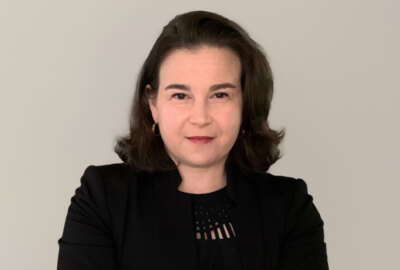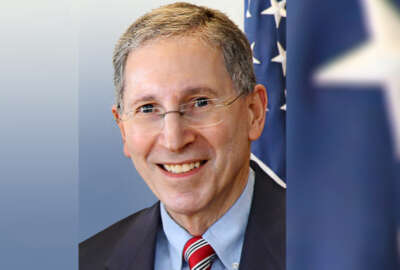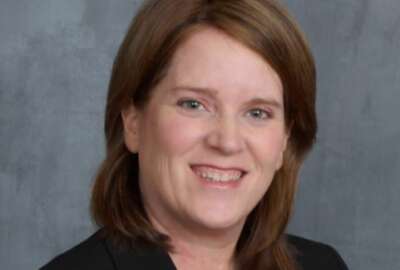Federal Employees of the Year: Sammies awardees were early architects of COVID vaccines
For their work, Kizzmekia Corbett and Barney Graham are finalists in this year's Service to America Medals program. Barney Graham joined Federal Drive with Tom...
Best listening experience is on Chrome, Firefox or Safari. Subscribe to Federal Drive’s daily audio interviews on Apple Podcasts or PodcastOne.
The most celebrated night in federal service returned Thursday as the Partnership for Public Service held its annual Samuel J. Heyman Service to America Medals Program ceremony in Washington, D.C. The hybrid in-person and virtual event honored civil servants from all walks of life and work, and named two National Institutes of Health doctors “Federal Employees of the Year.” Kizzmekia Corbett and Barney Graham began outlines for the COVID-19 vaccine only days after the pandemic began, and their work has helped save millions of lives since. Hear Graham’s Oct. 20 interview on Federal Drive with Tom Temin for more information.
Interview transcript:
Tom Temin: Dr. Graham, good to have you on.
Dr. Barney Graham: Thank you. It’s a pleasure to be here.
Tom Temin: January of 2020. that’s not that deep end of the whole problem, the Chinese did post the DNA I guess of the virus. What did you do next? What does the vaccine researcher do with DNA information? Tell us the process.
Dr. Barney Graham: This wasn’t the first Coronavirus that came through. We have four that circulate every winter and then we had a big SARS outbreak in 2002. We had a big MERS outbreak in 2012. And so since then, we’ve been working on coronavirus vaccines and we’ve solved the structures, the atomic level detail of their surface proteins. And we’ve learned how to design vaccines from those proteins. We’ve learned how to deliver it by RNA. And we had a project that we call it a prototype pathogen approach to pandemic preparedness that was already in process. So we had evidence that we could deliver a mRNA expressing a spike protein that was designed in a particular way and we could protect animals from lethal MERS coronavirus challenge. And that was the project, getting ready for a new virus. And so when that sequence came out, we had already decided ahead of time that we could modify that without any additional experimentation and just go right into manufacturing. And so we ran the drill, what we call the drill.
Tom Temin: In other words, you had almost 10 years of dress rehearsal for this big show.
Dr. Barney Graham: We were working toward this, we didn’t really know there would be a show, we didn’t want there to be a show, but we were working toward a quicker solution to vaccine pandemic response.
Tom Temin: Well, do you think that what you learned in dealing with those earlier COVID types of variations and in creating the vaccines for those, does that learning translate to say non COVID viry that might come along? Is there anything in the techniques that can translate out of the COVID domain, let’s say?
Dr. Barney Graham: Yeah, there’s 26 viral families that can infect humans or that are known to infect humans. And we’ve especially been working on two of them, paramyxoviruses and coronaviruses. We worked on others as well, but those two we’ve been working toward pandemic preparedness. And the coronavirus has seemed to be, that that family of viruses seems to be particularly susceptible to a single vaccine antigen design. So we know that we had already translated this into 12 different other coronaviruses and we knew that it would likely work. We know how to do the paramyxovirus process but it probably would be something that would take two or three months of experimentation before we’ve settled on final design. Some of the other viral families, it may take two to three years before we could get to a final design. So in some ways, we were very lucky it was a coronavirus that allowed us to respond quickly and we’re lucky that it happened this time instead of 20 years ago. If the first SARS had spread like this one has, we would have been in even worse shape.
Tom Temin: Because in the history of vaccine based problems. Sometimes it takes a generation or two to come up with a vaccine. I’m thinking of polio, for example, that was 50 years.
Dr. Barney Graham: Right. The respiratory syncytial virus which I’ve spent most of my career working towards, a lot of the work on RSV was the basis for what we did for coronavirus. And those, the findings that really mattered for the vaccine happened in 2013 – 12 and 13. And that vaccine development program is going well and it’s in late stage testing. But, it’s not likely to be licensed or we won’t have the information to be licensed until 2024 or so. So that’s more on a traditional path where you go from breakthrough to a vaccine in 10 or 12 years.
Tom Temin: We’re speaking with Dr. Barney Graham, he’s deputy director, or until recent retirement, of the Vaccine Research Center at the National Institutes of Health – and along with fellow researcher Dr. Kizzmekia Corbett, they’re finalists in this year of Service to America Medals program. And how important was it that the Chinese published the DNA sequence of the COVID-19 virus, and what form does that take? Do they send you a slide drawing, a set of computer printouts? What does it look like?
Dr. Barney Graham: These coronaviruses have an RNA genome, so it was an RNA sequence and that is composed of four different nucleotides, a CTG set of nucleotides, those create a three letter code to tell cells what protein, how to make a protein. And so what we got out of, these viruses have about a 30,000 nucleotide long genome. So we got a sequence of A, T, C, Us or Ds, and it was a long set of letters that we got. And you can translate those into what the protein would be, you can align those protein sequences or the amino acid sequences with other coronaviruses that we worked on before. And we can find the places that we need to make modifications and just pull out the spike protein, the spike proteins about 10% of that. And so we can find the spike protein code within that sequence and we can align it with other coronavirus spikes we’ve worked on and then we can use that information to say this is the protein we want to make.
Tom Temin: And from the discovery of the protein you want to make to actually making the protein, that of course is something that drug companies did — what did that require?
Dr. Barney Graham: What you do then is you take that sequence, you make a DNA that can come in code for the RNA that makes the protein. And so we can synthesize DNA. And so we synthesize DNA in the correct sequence so that we can make protein structures to make assays, a sequence that Moderna, who we worked with directly, used to make the vaccine. And so we made protein for a lot of different types of reasons. And in the case of the RNA vaccines, the body actually makes the protein. So the way this works is you you put the code into the RNA, and as you deliver the RNA, it can go into a muscle cell or another cell. And those cells then become the factory, instead of making the protein in a factory, which some companies are doing. In this case, the body is making the protein. And when the body sees that foreign spike protein, it makes an antibody response and the T-cell responses, and that’s what creates your immunity.
Tom Temin: And you’ve been chasing this kind of thing for a long career. Do you ever look at these viruses and think of them as enemies that you really want to stamp out?
Dr. Barney Graham: I guess I see them as puzzles, mostly. But the virus disease itself is our enemy. I mean, that’s what all of us should be standing against the viruses. Not having controversy about other things, we all need to kind of align ourselves against the virus, not against each other.
Tom Temin: The ability to solve this problem to some extent in a weekend, according to the citation from the Sammies awards, that must be something you probably couldn’t have envisioned 20, 30, 40 years ago.
Dr. Barney Graham: No. The technology we have today, I could not have envisioned it 20 or 30 years ago. I came to the VRC, I came to work in federal government in 2000, a little over 20 years ago. And at that time, we had dreams and ideas but the technologies to do this kind of work really has been developed over this last 20 years. And so the kinds of things we did this time really are a consequence of technologies that have been developed over the last 10 years. But it has been driven largely by work. It’s been what we’ve tried to do on HIV vaccines for the last 40 years. So it’s really that original investment in HIV research and HIV biology and vaccine biology that has led to the new tools we have now to address some of these other problems.
Tom Temin: Now that you are retired should say COVID-20, come around or COVID-21, will you be available on speed dial to to head back up to DC and help them solve that one?
Dr. Barney Graham: Well, I’ve retired from the federal government after 21 years, but I really consider this a repositioning. So I’m not exactly retired. I think maybe life right now is busier than it was even before because there’s still a lot of loose ends to clean up. And so I’m going to consult back to the VRC and other parts of government, and I’m going to be available and still be in the fight, just from a different position.
Tom Temin: Dr. Barney Graham was deputy director of the Vaccine Research Center at the National Institutes of Health. Thanks so much for joining me.
Dr. Barney Graham: Thank you very much. It’s a pleasure to be here. And I really should just say one thing about Dr. Corbett who came to my lab as a postdoctoral fellow in 2014 and selected coronaviruses as her choice to work on with me, and we had started this project that it was right in the beginning after the MERS outbreak in 2013. So she has been in this with other collaborators at other universities for a long time, prior to this getting us ready to make this response. So she’s not here with us right now, but I can tell you in the beginning of 2020 she was very important for getting this work quickly started.
Tom Temin: And that’s Dr. Kizzmekia Corbett, and she and Dr. Graham are finalists in this year’s Service to America Medals program.
Copyright © 2025 Federal News Network. All rights reserved. This website is not intended for users located within the European Economic Area.
Tom Temin is host of the Federal Drive and has been providing insight on federal technology and management issues for more than 30 years.
Follow @tteminWFED






